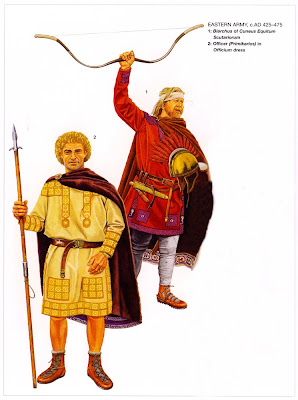Roman soldiers in the fifth century AD
early fifth century AD the Roman image of the military is basically very similar to that of the previous century. The big "factories" of military equipment will continue to produce large oval shield on which are painted the portrait of the wide range of departments. The crested helmets of Roman-Sassanid type are always present but at the same time, those segmented conical spread further, especially in the ranks of the cavalry and newer richly decorated. The armor of chain mail or bronze flakes are always produced ma si assiste ad una forte diffusione di quelle lamellari, forse anche in virtù della loro semplicità costruttiva .
Elmi rotondi di semplice ma robusta fattura, composti da segmenti rivettati, fanno la loro comparsa, dotati quasi sempre di paranuca in maglia di ferro e sono adottati per lo più dalle fanterie .
The helmet with a metal crest of horsehair or feathers and features the highest-ranking departments or guard the Emperor.
From the time of Theodosius on the effigies and shields with the symbol "P" and "X "cross became the symbol of this new empire" Romano-Christian "
troops implicated by the Emperor called "candidates" dress tunics and weapons on the level of decoration in harmony with those of the emperor himself. They are often of Germanic origin and keep long hair cut in a way that will become common throughout the Middle Ages, the face is shaved in a historical moment that matches the aesthetic values \u200b\u200bof the Roman lost.
Cavalry undergoes a transformation in this century than in the previous century: the Parthian catafratta type, the Kontari by fully armored horses, a decrease in favor of a medium heavy cavalry using either bow and spear from shock and defends himself with armor-type scale Sarmaticus or laminated.
When the horse is protected by a shell, it is often a rectangular and covers only the front.
The combination of a shooting arrows to mess up the enemy followed by a post at the spear, will be a secret weapon that will continue to exist for centuries, the Byzantine Empire.
Even the appearance of the infantry units is anything but uniform units of soldiers protected auxiliari lightly armed with axes or other weapons rather than derived from their ethnic background.
Hun Warriors often make up the personal guard military commanders, always consists of mounted troops.
The spread of the arc features in the Roman cavalry troops of the East.
The spread defenses laminated conical helmets and segmented in the continuation of the second half of the century featuring the appearance of this Roman Commander:
And this Gothic Commander in the service of the Empire.

















0 comments:
Post a Comment